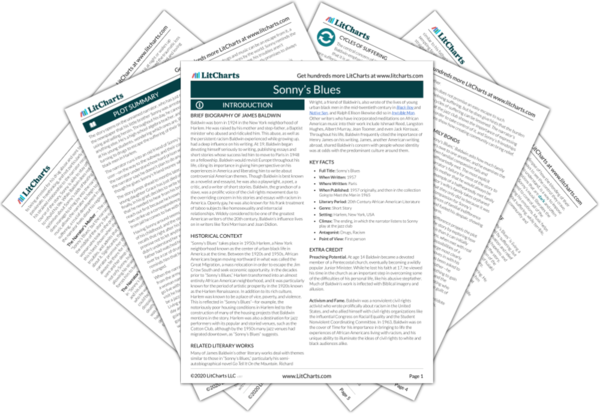Welcome to the LitCharts study guide on James Baldwin's Sonny’s Blues. Created by the original team behind SparkNotes, LitCharts are the world's best literature guides.
Sonny’s Blues: Introduction
Sonny’s Blues: Plot Summary
Sonny’s Blues: Detailed Summary & Analysis
Sonny’s Blues: Themes
Sonny’s Blues: Quotes
Sonny’s Blues: Characters
Sonny’s Blues: Symbols
Sonny’s Blues: Literary Devices
Sonny’s Blues: Theme Wheel
Brief Biography of James Baldwin

Historical Context of Sonny’s Blues
Other Books Related to Sonny’s Blues
- Full Title: Sonny’s Blues
- When Written: 1957
- Where Written: Paris
- When Published: 1957 originally, and then in the collection Going to Meet the Man in 1965
- Literary Period: 20th Century African American Literature
- Genre: Short Story
- Setting: Harlem, New York, USA
- Climax: The ending, in which the narrator listens to Sonny play at the jazz club
- Antagonist: Drugs, Racism
- Point of View: First person
Extra Credit for Sonny’s Blues
Preaching Potential. At age 14 Baldwin became a devoted member of a Pentecostal church, eventually becoming a wildly popular Junior Minister. While he lost his faith at 17, he viewed his time in the church as an important step in overcoming some of the difficulties of his personal life, like his abusive stepfather. Much of Baldwin’s work is inflected with Biblical imagery and allusion.
Activism and Fame. Baldwin was a nonviolent civil rights activist who wrote prolifically about racism in the United States, and who allied himself with civil rights organizations like the influential Congress on Racial Equality and the Student Nonviolent Coordinating Committee. In 1963, Baldwin was on the cover of Time for his importance in bringing to life the experiences of African Americans living with racism, and his unique ability to illuminate the ideas of civil rights to white and black audiences alike.







